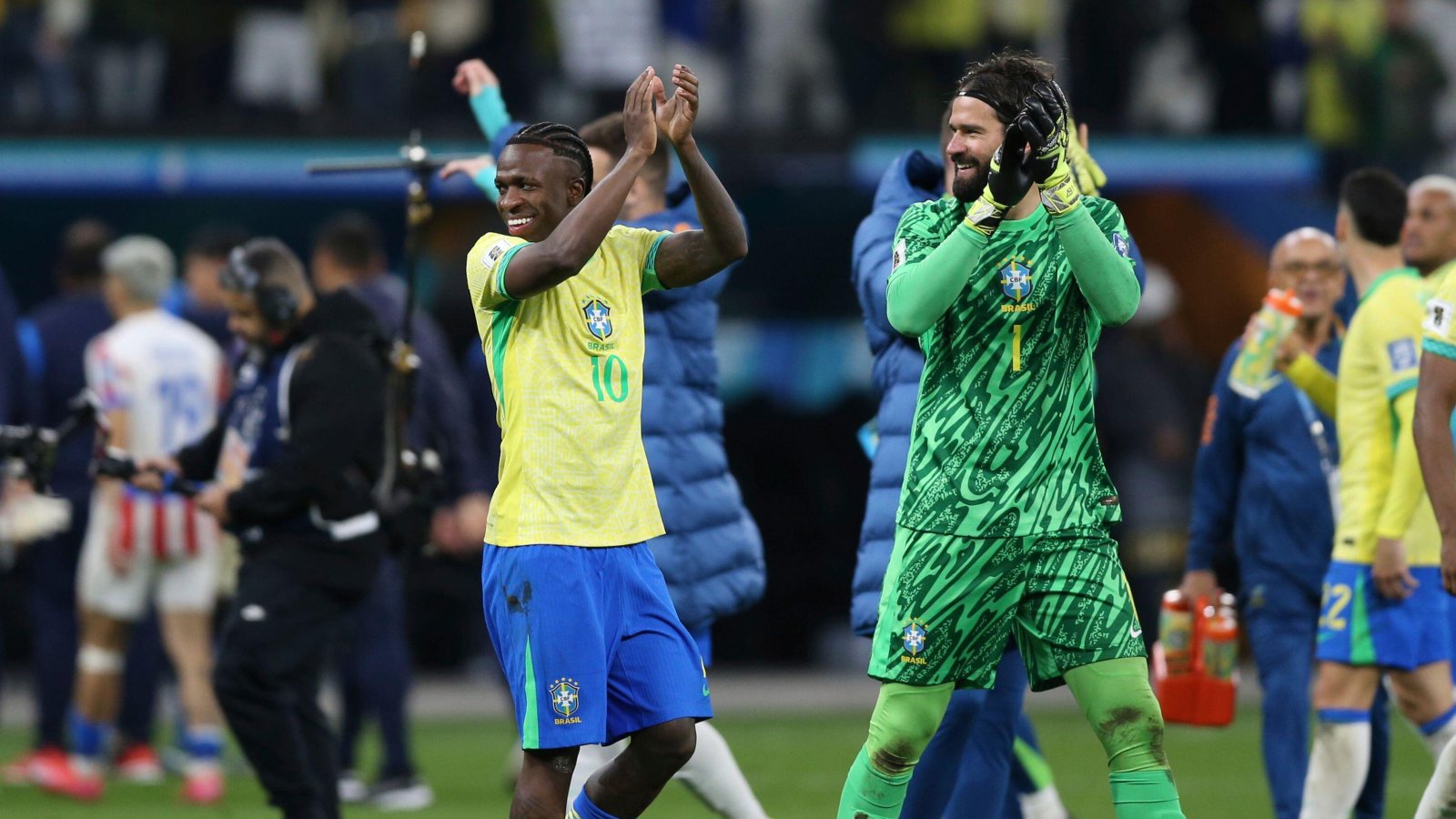
Who has already qualified for the World Cup?
You know what’ll be here before we know it? The World Cup. Yeah.
It’s a) barely eight months away and b) absolutely bloody massive. Some might suggest it is, if anything, Clive, almost too massive. As you no doubt know by now there are a frankly unwieldy 48 teams heading to USA, Canada and Mexico next summer and that means the various qualification processes across FIFA’s six continental confederations all look a bit different this time.
All apart from CONMEBOL, of course, who remain rightly and righteously wedded to their lovely 10-team league. It is, admittedly, an option not really open to any of the other confederations.
Anyway, what we’re driving at is that it’s already high time we take a look at how these various qualification tournaments are progressing – and some of them have five separate stages so it’s all going to take a bit of unravelling.
We now know 21 of the 48 and can start to have a decent go at guessing a good chunk of the remaining 27, one of which is almost certainly England.
The 21 teams who have qualified for the 2026 World Cup:
USA (hosts)
Mexico (hosts)
Canada (hosts)
Argentina (CONMEBOL)
Ecuador (CONMEBOL)
Brazil (CONMEBOL)
Uruguay (CONMEBOL)
Colombia (CONMEBOL)
Paraguay (CONMEBOL)
Japan (AFC)
Iran (AFC)
Uzbekistan (AFC)
South Korea (AFC)
Jordan (AFC)
Australia (AFC)
Morocco (CAF)
Tunisia (CAF)
Egypt (CAF)
Algeria (CAF)
Ghana (CAF)
New Zealand (OFC)
2026 World Cup qualification: UEFA (Europe)
Total teams: 54
Total 2026 World Cup spots: 16
Already qualified: None
Can still qualify: 44
How it works:
Still a lot to play out in UEFA’s qualification process, with plenty of teams only getting up and running last month in the four-team groups.
The 54 teams have been split into 12 qualifying groups, half with five teams and half with four. The four teams who made it to the last four of the Nations League are all in late-starting four-team groups so they could conclude that Nations League hooplah, while the five-team groups could have no more than one team involved in Nations League title/promotion/relegation palaver, who sat out the first round of games and only got involved in June.
Everyone else in the five-team groups kicked off in March.
The 12 group winners all qualify directly for the World Cup, with the 12 runners-up plus the four highest-ranking Nations League group winners who have finished outside the top two in their groups then setting off down four play-off routes to settle the four remaining places.
That does provide a potential safety net for both England and Wales, who are ranked fifth and seventh respectively among Nations League group winners after their triumphs in League B and would thus be almost certain to be handed a play-off spot even if they did finish outside the top two of their groups.
Even Northern Ireland down in 12th after a League C win will likely find themselves in the play-offs via that route if need be given the likelihood of most Nations League group winners above them finishing in the top two of their qualifying groups anyway.
One general thing to note is that UEFA are pound-for-pound the smallest ‘winner’ from the World Cup’s expansion having gained only three spots from 2022’s 13. Unlike everywhere else, it isn’t conspicuously easier to qualify now than it was before. UEFA is also the only confederation that won’t be represented at the inter-confederation play-offs.
Likely qualifiers:
England are almost there, needing just one win from their remaining games to confirm their place in North America next summer. Their first chance comes against Latvia on Tuesday night.
Wales, Scotland and Northern Ireland all look set for at least a play-off spot one way or another.
Norway have won six out of six and are on the brink of confirming a World Cup place for the first time since 1998. They are already guaranteed at least second place and a play-off spot but it would be miraculous now if they were to miss out on automatic qualification.
France, Spain and Portugal would all have to do something quite silly from here not to win their groups from their current lofty, flawless perches, while Austria, Netherlands, Croatia and Switzerland have all now put themselves in charge of potentially trickier sections of the draw.
You’d still expect class and experience to tell for Germany and Belgium, but both still have plenty to do after not entirely convincing thus far, while Denmark are at this stage the most tentative pick of the group winners, with nothing to choose between them and Scotland. They are both now assured of a top-two finish in that group and with it at least a play-off spot.
Potential runners-up who will head to the play-offs include – with varying degrees of confidence – Slovakia, Kosovo, Scotland, Ukraine, Turkey, Hungary, Poland, Bosnia, Italy, North Macedonia, Albania and Czech Republic.
If – and it is still a very, very big if – those are indeed the 12 group winners and 12 runners-up from World Cup qualifying, then the four Nations League group winners who would make it to the play-offs alongside those 12 runners-up would be Wales, Romania, Sweden and Northern Ireland.
Wales and Northern Ireland still have a decent shot at a top-two finish in their World Cup groups anyway. If Wales do make it, it would likely come at the expense of North Macedonia who would then almost certainly land in the play-offs themselves. Wales are ranked seventh among the Nations League group winners, and North Macedonia 11th. A look at the teams above them suggests neither would have any concerns about being among the four highest to finish outside an automatic qualification or play-off spot.
Romania are struggling for a top-two finish in a group dominated by Bosnia and Austria, while Sweden are making a horrible mess of things currently in Switzerland’s group having managed just one point from three games. Those two are definitely the likeliest to profit from Nations League results given their prominent ranking there and current struggles.
It’s still possible that Moldova or even San Marino could appear in the play-offs; they are the Nations League Group D winners and Moldova certainly could easily find that nine of the 12 teams above them in the play-off lists finish in the top two. Norway definitely will, while Spain, Portugal, France, and England all almost certainly will, while Germany and Czech Republic definitely should (the latter despite the Faroe Islands currently making an exhilaratingly bold run at doing a complete madness by pipping them to second spot).
Romania and Sweden will almost certainly take two of the four spots, along with whichever one of Wales or North Macedonia finishes third in their group (assuming for now they don’t both nudge out Belgium altogether).
If all that were to happen, which it should, then as long as Germany and Northern Ireland take the top two spots in Group A, Moldova are in the play-offs.
If Wales and North Macedonia do indeed manage to nudge Belgium down to third in Group J, then San Marino are in business.
READ: Who are the current favourites for the 2026 World Cup?
2026 World Cup qualification: CAF (Africa)
Total countries: 53
Total 2026 World Cup spots: 9 + 1 inter-confederation play-off
Already qualified: Morocco, Tunisia, Egypt, Algeria, Ghana
Can still qualify: 13
How it works:
Jumping from five qualifiers for 2022 to nine (and a half) for 2026 has required a reworking of the African qualifying format.
There are (or at least were) nine groups of six, with each group winner going to the World Cup, and the four best runners-up heading for play-offs to secure a spot in the last-chance-saloon inter-confederation play-offs (about which more later) that take place next March.
That runner-up ranking bit has been rendered distinctly messy by the fact Group E now contains only four teams rather than six following Congo’s suspension and Eritrea’s withdrawal.
The competing nations have apparently been informed that results against the sixth-placed team in the group will be discounted from the runners-up rankings, but this has not yet been officially or publicly announced.
Likely qualifiers:
The main group stage is nearly done now, with plenty of group winners and therefore qualifiers starting to be confirmed. 2022 World Cup semi-finalists Morocco were the first to seal their place at next summer’s tournament, with Tunisia, Egypt, Algeria and Ghana all also now confirmed as group winners.
Senegal hold a two-point lead over DR Congo in Group B, and a home win over eliminated Mauritania would confirm their World Cup place.
Other groups are still too close to call, though, with some potential upsets around the place.
Cameroon now trail Cape Verde by two points in Group D, while Ivory Coast hold only a one-point advantage over Gabon in Group F. Whoever does finish second in Group F is already assured of a play-off spot.
Nigeria are struggling to top Group C now, trailing Benin by three points and South Africa by one heading into the final games. They must beat Benin and hope South Africa don’t beat Rwanda.
South Africa had appeared to be in complete control of that group, but fielding an ineligible player has seen a 2-0 win over Lesotho become a 3-0 loss to leave it wide open again.
Still hard to say with any certainty who the four best runners-up will be – especially with lingering uncertainty on how they’ll even be calculated in the end – but the current best guess would appear to be Gabon (or Ivory Coast if they finish second in that group), Cameroon, DR Congo, and Burkina Faso.
2026 World Cup qualification: AFC (Asia)
Total countries: 46
Total 2026 World Cup spots: 8 + 1 inter-confederation play-off
Already qualified: Japan, Iran, Uzbekistan, South Korea, Jordan, Australia
Can still qualify: Qatar, UAE, Oman, Saudi Arabia, Iraq
How it works:
It’s a long old process, with five stages – the first two of which also served as qualification for the 2027 AFC Asian Cup.
Luckily it all got under way right back in October 2023 and we’re now into stage four.
That’s made up of the six teams who finished third and fourth in the three third-stage groups, the top two in each group having already qualified for next summer’s event. With us so far? Good.
The remaining six have been split into two groups of three. It’s a single round-robin for this stage, with all matches taking place at centralised venues during this international break.
Qatar will host Group A, also featuring UAE and Oman. Saudi Arabia will host Group B, which also contains Iraq and Indonesia.
The two winners of those groups will also qualify for the World Cup, and the two runners-up go to stage five: a two-legged continental play-off for a spot in the intercontinental play-off.
Look, not everyone is or can be as straightforward about these things as CONMEBOL.
Likely qualifiers:
We know the six direct World Cup qualifiers from the third round.
Iran and first-time qualifiers Uzbekistan are through in Group A.
South Korea and Jordan – another first-time qualifier – are through from Group B.
Japan dominated Group C and will be joined in North America next summer by Australia.
Saudi Arabia and Iraq have both beaten Indonesia in Group B of the fourth round, meaning Indonesia are eliminated and the remaining game, between Saudi Arabia and Iraq becomes a straight scrap for qualification. A win or draw takes Saudi Arabia through, Iraq need a win. Whoever misses out is at least guaranteed a place in the play-off against the other group runner up for a spot in the intercontinental play-offs.
UAE will win that group if they avoid defeat against Qatar in the final game; if they beat Qatar, then Qatar won’t even make the play-off clash. Oman the ones watching on with interest there.
2026 World Cup qualification: CONCACAF (North America, Central America and Caribbean)
Total countries: 32 (plus USA, Mexico and Canada)
Total 2026 World Cup spots: 6 + 2 inter-confederation play-offs
Already qualified: USA, Mexico and Canada
Can still qualify: 12
How it works:
Six direct qualification spots plus a double helping of play-off action sounds very exciting, but you do have to remember half of those six direct spots have already been claimed by the hosts.
Nevertheless, the removal from the qualification process of the two traditional CONCACAF powerhouses in USA and Mexico in particular still offers all kinds of chances for all kinds of teams.
With the hosts accounted for and a couple of play-offs eliminating the lowest-ranked teams, the remaining 30 CONCACAF members were split into six groups of five for a single round-robin (i.e. two home games, two away) with the top two from each of those groups going to the final stage where the remaining 12 teams are now in three groups of four.
Those groups play out a full home-and-away round-robin across the September, October and November international breaks with the three group winners off to the World Cup, and the best two runners-up heading to the intercontinental play-offs.
Likely qualifiers:
It’s incredibly tight at the halfway stage in all three final qualification groups with no clear favourites at this time. Suriname and Panama are level on five points at the top of Group A, with El Salvador (3pts) and Guatemala (2pts) still very much in the mix.
Haiti and Honduras are also level on five points at the top of Group C, with Costa Rica two points further back, while Curacao lead Jamaica by a single point in Group B.
Even the second-place rankings for intercontinental play-off spots are currently too close to call, with the three very much unconfirmed second-place teams currently being Jamaica (6pts), Honduras (5pts) and Panama (5pts).
2026 World Cup qualification: CONMEBOL (South America)
Total countries: 10
Total 2026 World Cup spots: 6 + 1 inter-confederation play-off
Qualified: Argentina, Ecuador, Brazil, Uruguay, Colombia, Paraguay
Qualified for inter-confederation play-offs: Bolivia
South American qualifying has always possessed a pleasing straightforwardness, and the expansion of the finals had no real impact on this beyond further diluting what little jeopardy exists for the stronger nations.
It remained a clean and simple 10-team league, with everyone playing everyone else home and away. Just now with over half of those teams earning a direct path to the finals, and the team in seventh heading to the intercontinental play-offs where they should have a very good chance of success anyway.
Holders Argentina secured qualification several matchdays ago and finished up a whopping nine points clear at the top. They were followed home by Ecuador, Colombia, Uruguay, Brazil and Paraguay, those five teams ending up separated by a single point and all safely through.
Venezuela had looked set for the play-off spot across much of the campaign, but missed out at the very last to Bolivia after a wild 6-3 defeat to Colombia in their final game.
Even that result left Bolivia still needing to beat Brazil in their own final game, which they did. Peru and Chile had terrible campaigns, winning just two games apiece and finishing well adrift of the rest.
2026 World Cup qualification: OFC (Oceania)
Total countries: 11
Total 2026 World Cup spots: 1 + 1 inter-confederation play-off
Qualified: New Zealand
Qualified for inter-confederation play-offs: New Caledonia
The ins and outs don’t really matter now, with the OFC qualification campaign boxed off and squared away before some teams in other parts of the world had even begun.
Suffice to say it ended entirely unsurprisingly with New Zealand – very much the dominant force in the post-Australia OFC and thus one of the biggest long-term winners to emerge from the 48-team expansion – securing the confederation’s first ever direct-qualification World Cup spot with a 3-0 win over New Caledonia, who still have the chance to do a madness in the inter-confederation play-offs.
2026 World Cup qualification: Inter-confederation play-offs
Total countries: 6
Already qualified: New Caledonia (OFC), Bolivia (CONMEBOL)
Total 2026 World Cup spots: 2
How it works:
New Caledonia and Bolivia will be joined by two teams from CONCACAF and one each from AFC and CAF as detailed above in a quickfire tournament to be played in Mexico in March next year.
The four qualifiers ranked lowest by FIFA will meet in a pair of one-off semi-finals for the right to face the two highest-ranked teams in one-off finals that will decide the final two qualifiers for the 2026 World Cup.











